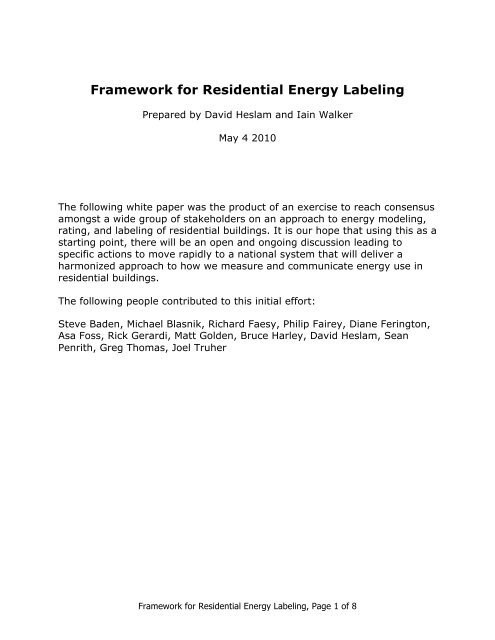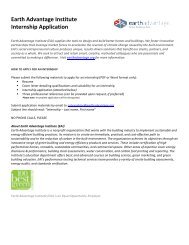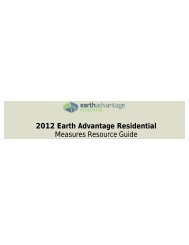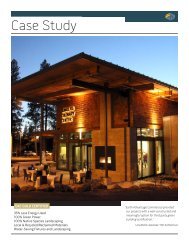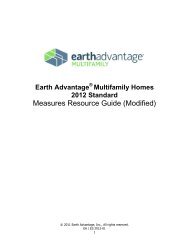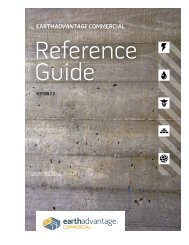Download PDF (100 KB) - Earth Advantage
Download PDF (100 KB) - Earth Advantage
Download PDF (100 KB) - Earth Advantage
You also want an ePaper? Increase the reach of your titles
YUMPU automatically turns print PDFs into web optimized ePapers that Google loves.
Framework for Residential Energy Labeling<br />
Prepared by David Heslam and Iain Walker<br />
May 4 2010<br />
The following white paper was the product of an exercise to reach consensus<br />
amongst a wide group of stakeholders on an approach to energy modeling,<br />
rating, and labeling of residential buildings. It is our hope that using this as a<br />
starting point, there will be an open and ongoing discussion leading to<br />
specific actions to move rapidly to a national system that will deliver a<br />
harmonized approach to how we measure and communicate energy use in<br />
residential buildings.<br />
The following people contributed to this initial effort:<br />
Steve Baden, Michael Blasnik, Richard Faesy, Philip Fairey, Diane Ferington,<br />
Asa Foss, Rick Gerardi, Matt Golden, Bruce Harley, David Heslam, Sean<br />
Penrith, Greg Thomas, Joel Truher<br />
Framework for Residential Energy Labeling, Page 1 of 8
Summary<br />
This paper proposes a framework for national standards regarding residential<br />
energy labeling and energy retrofit audits. There is a growing consensus<br />
around the importance of a national building energy labeling standard in the<br />
residential sector. Such a standard would serve to stimulate energy<br />
efficiency and its associated carbon emission reductions in the built<br />
environment. The standard would apply to Energy labels generated by<br />
simple audits as well as more in-depth retrofit audits that provide finer<br />
resolution of energy modeling require for estimates for financing, incentives,<br />
and upgrade decision-making.<br />
Even though these two types of energy analysis serve different but related<br />
purposes, the two must be harmonized in their delivery and methodology.<br />
Both are in need of a unified set of standards. This paper recommends<br />
actions to implement the energy labeling standards that will ensure synergy<br />
of these audits in the marketplace.<br />
The concepts presented here stem from a representative group of residential<br />
energy efficiency industry members, working under no particular affiliation.<br />
The proposal is intended to form the basis for continued discussion by a<br />
broader group of industry and government representatives.<br />
The recommendations described in this paper are:<br />
• An energy label should be an asset value.<br />
• An energy retrofit audit should produce savings estimates that include<br />
operational values<br />
• Home energy performance should be expressed in terms of three<br />
metrics: site energy by fuel type, associated carbon emissions and site<br />
energy costs.<br />
• For natural gas the carbon emissions can be calculated directly from<br />
the site burned fuels natural gas, propane or wood. For electricity, the<br />
simplest and most robust carbon conversion method is to use a<br />
national average conversion factor.<br />
• Two levels of granularity are recommended for the metrics.<br />
o 2500 kWh resolution for a building energy label.<br />
o 250 kWh resolution for Energy Audits.<br />
• A minimum set of required data fields to be collected for labeling and<br />
energy audits should be defined by DOE in consultation with<br />
stakeholders. The data set collected may vary with the purpose of the<br />
calculation and type of rating.<br />
• DOE should investigate the technical requirements and marketing<br />
pathways for a broad range of potential users.<br />
Framework for Residential Energy Labeling, Page 2 of 8
• DOE should provide funding for development of improved calculation<br />
methods for estimating energy use. This includes, but is not limited to,<br />
development of ANSI/ASHRAE Standard 140 and the BESTEST-EX<br />
evaluation procedures.<br />
• As data are collected for audits that include both the energy use<br />
estimates and bills - these data should be captured in a national<br />
database and used as a tool to improve future modeling/energy<br />
estimating efforts.<br />
• DOE should adopt minimum standards for training and certification of<br />
auditors in consultation with industry, but should default to industry<br />
standards until such time that a consensus standard has been<br />
developed.<br />
• A signed utility bill release form by building owners should be a<br />
prerequisite to acceptance of Federal energy efficiency incentive funds.<br />
Members of industry endorsing this paper stand ready to assist the<br />
administration in the development of these standards.<br />
Potential Users and End-uses<br />
The details of what is included on the label, its physical appearance, and<br />
other attributes depend on both the user and end-use of the label. It is<br />
possible that some aggregation could simplify the development of label<br />
marketing strategies. One way to aggregate could be by end uses, such as<br />
real estate transaction, home improvement, remodeling, equipment<br />
replacement and meeting minimum code requirements. A second way to<br />
aggregate is by user categories that can be broken down into two groups:<br />
1. Those who already perform activities related to labeling (this includes<br />
both contractors and program managers), such as: HERS raters/consultants,<br />
Home Performance with Energy Star contractors, home inspectors, low<br />
income weatherization and remodellers.<br />
2. Those for whom energy assessment of homes is a new idea: home<br />
buyers, home sellers, homeowners thinking about renovation/retrofit,<br />
realtor, mortgage broker, loan officer, appraiser, builder, utilities, ESCOs,<br />
state energy offices and energy efficiency program managers.<br />
In both developing the label and marketing the label to get it adopted we<br />
need to understand the different needs/requirements of these groups and<br />
target them accordingly by going through channels they already use, for<br />
example contractors can best ne reached via national retailers and HVAC<br />
equipment distributors.<br />
Framework for Residential Energy Labeling, Page 3 of 8
For each group we need to consider the purpose of the label. Examples are:<br />
to allow financing for mortgage brokers and loan officers, personal pride for<br />
homeowners, and identification of target homes for utility programs.<br />
What needs to be developed is a strategy for the technical aspects of what is<br />
included on a label and how to ensure that the label is used that is applicable<br />
to all these potential end uses and users.<br />
Asset Values and Operational Values are Different<br />
An asset value label provides an assessment of energy use of the home<br />
based on the physical characteristics built into the home and a standardized<br />
set of operating characteristics. The specific characteristics taken into<br />
consideration for producing a label are dependent on the level of accuracy<br />
required. An operational value label is based on the actual energy use of a<br />
home. An operational value can be used to help improve the accuracy of an<br />
asset value label via calibration of the underlying physical building<br />
simulation.<br />
Energy Labels Should Be Asset Values<br />
It is recommended that an energy label be an asset value, this will allow the<br />
label to represent the comparative energy consumption of a building. A likely<br />
use of asset labels is at time of sale of a home (DOE is initiating a pilot study<br />
with HUD/FHA at the time this document is being prepared that will provide<br />
useful information on this topic). Given the intrinsic change in occupants,<br />
the asset label is vital because billing data may not be a good indicator of<br />
energy use by different occupants.<br />
Standard operating conditions need careful definition for an asset label to be<br />
effective across housing types, sizes and geographic areas. RESNET has<br />
created a recognized methodology for defining standard operating<br />
conditions. This methodology, which provides for lighting, appliances,<br />
miscellaneous plug loads, standard heating and cooling set points, should be<br />
updated by further development of standards for lighting, appliance and<br />
miscellaneous load modeling. Significant installed end uses such as saunas,<br />
hot tubs, and pools should also be considered in asset ratings. To make<br />
results comparable to actual energy bills and to the operational value label,<br />
DOE should explore the possibility of developing an energy calculation<br />
standard that include estimates of all installed end uses on the asset label.<br />
Those end uses not permanently installed in the building should be set at<br />
occupancy-neutral default values. Ongoing research into lighting, appliance<br />
and miscellaneous load use should be incorporated into this standard over<br />
Framework for Residential Energy Labeling, Page 4 of 8
time to ensure that the asset label is reflective of typical consumption<br />
patterns.<br />
Energy Audits Should Utilize Operational Values to Predict Savings<br />
An operational value label in its simplest form is the actual energy consumed<br />
by a building. Normalizing previous utility bills for weather would provide<br />
standardization of this type of information. This operational value would<br />
provide the energy consumption of the building as it is used by the current<br />
occupants. It is this value that should be used for predicted savings when<br />
building occupants are to remain the same. Energy Audits that are tasked<br />
with generating specific work scope and estimating detailed energy savings<br />
by individual upgrade for individual homes and occupants should utilize an<br />
operational value.<br />
Accuracy of Energy Modeling Software<br />
Building energy labels need to be trustworthy, consistent and widespread to<br />
be effective. This is best achieved by having energy labels and energy<br />
savings predictions produced by the most accurate modeling software<br />
available. Current models often perform poorly because of a combination of<br />
three issues:<br />
1. Occupant variability: number of occupants, hours of occupancy, pets,<br />
frequency of laundry/showering/eating at home, etc.<br />
2. Problems with physical representation: thermal distribution losses,<br />
buffer spaces (attics, crawlspaces and attached garages), ventilation,<br />
foundation heat loss, hot water use, and<br />
3. User input estimates and user understanding of requested input data.<br />
The first of these issues requires detailed questioning and honest answering<br />
of questions by occupants. For an asset label this is overly burdensome, but<br />
for operational rating whoever is performing the rating will require this level<br />
of detailed interaction on order for a good work scope to be developed and<br />
will be a requirement for successful work.<br />
The second issue can be addressed through engineering analyses, field<br />
studies and partnership with other industry bodies, who are also addressing<br />
these issues. It is recommended that DOE fund research and collaborative<br />
efforts in this area.<br />
The third issue needs DOE sponsored research to determine which input<br />
data are most critical and efforts on clarifying default inputs and on input<br />
Framework for Residential Energy Labeling, Page 5 of 8
strategies that make it less likely that input errors are made and that help<br />
users to understand the input data.<br />
To further address these issues it is recommended that DOE undertake<br />
substantial field studies (on the order of thousands of homes) in order to<br />
evaluate occupant survey protocols, develop databases for model<br />
comparison and development, and for potential users to learn the<br />
requirements, limitations and to develop a core understanding of home<br />
energy labeling. DOE should maintain a database of homes that have<br />
undergone labeling and/or audited retrofitting to facilitate progress in this<br />
area.<br />
To address issue of trust and consistency, there needs to be an arbiter of<br />
equivalency for energy estimating tools. DOE is ideally situated to be this<br />
arbiter. Therefore DOE needs to develop both the technical and<br />
administrative mechanisms for certifying energy estimating tools. The<br />
current technical method is best served by using BESTEST-EX while working<br />
on improving technical aspects of the procedure including more detailed<br />
comparisons to measured field data and automated model calibration.<br />
recognizing the shortcomings associated with comparing models to other<br />
models rather than measured data. The administrative mechanism needs to<br />
be created whereby DOE certifies, and documents this certification, of<br />
energy estimating tools that may be used for labeling.<br />
DOE’s own home energy rating software, Home Energy Saver (HES), should<br />
be further developed as a tool suitable for labeling. Advances to HES should<br />
be integrated with development of BESTEST-EX and other methods of<br />
comparing rating tools. DOE should support large scale field studies in<br />
hundreds of homes to provide the data required for model improvements<br />
and assessing model accuracy.<br />
DOE should set reasonable accuracy limits for modeling software. An<br />
example would be: “Over a large sample of homes more that half the<br />
predictions must be within 25% of the actual energy use from billing data<br />
and the average error must be less than 20%”.<br />
Defining the Home Energy Label<br />
There are two main issues to address in defining a home energy label. The<br />
first is the selection of metrics to include on the label and the second is the<br />
graphical format.<br />
Framework for Residential Energy Labeling, Page 6 of 8
It is recommended that the asset label contain two metrics: total site energy<br />
by fuel type and total estimated carbon emissions. The operational label<br />
should add the total cost of site energy.<br />
The most likely candidate for carbon conversion factor is to use a single<br />
national value. This national value should be based on gas turbine<br />
generated electricity because the majority of marginal electricity is<br />
generated this way. Similarly, the cost of site energy should be a national<br />
average value for the asset label. DOE has plans to have a national database<br />
of labeling information such that the cost of energy could be updated<br />
periodically as energy costs change.<br />
It is recommended that two levels of granularity be utilized for generating<br />
labels. Although calculations could be performed with higher resolution,<br />
asset values should have labels with energy consumption defined by steps of<br />
2500 kWh (10 MBtu). Operational values resulting in an actionable work<br />
scope will require more detailed energy analysis and would generate labels<br />
with steps of 250 kWh (1 MBtu). The label will include the fuel use<br />
breakdown in kWh, therms, gallons of oil or propane, cords of wood, etc., to<br />
match what a homeowner sees on their bills.<br />
In addition to the energy metrics it is recommended that the following<br />
information be included in the label: water use and top 5 end uses. For<br />
various potential users of the label, other information should be optional,<br />
such as: comparison to other similar homes, comparison to a new code<br />
compliant home, comparison to a reach target (e.g., 35% better than code),<br />
and recommendations for home energy upgrades.<br />
Data Collection Requirements<br />
Data collection requirements for building energy labeling and energy<br />
auditing should be standardized. There should be separate standards for<br />
energy labeling audits and energy retrofit audits. It is recommended that the<br />
minimum set of data to be collected should be defined by DOE in<br />
consultation with stakeholders to ensure that the data collected would be<br />
compatible with the requirements of a national database.<br />
Data collection standards go beyond just what data are collected for each<br />
home, but also how the data are collected. A prerequisite for a successful<br />
building energy label program is that the system is viewed as trustworthy so<br />
the technical standards for data collection should reference existing audit<br />
standards developed by industry. Standards for collecting data to generate<br />
energy labels should introduce the use of diagnostic equipment.<br />
Framework for Residential Energy Labeling, Page 7 of 8
Additionally, a standard protocol for communicating audit data between<br />
database systems should be developed and standardized. Standardized form<br />
should be developed by DOE that are required to be completed in order that<br />
retrofits are eligible for Federal funding. DOE should establish a national<br />
database of labeling data. This database should be coordinated with other<br />
survey instruments, such as the Residential Energy Consumption Survey<br />
(RECS).<br />
Rater Infrastructure<br />
With the current increase in demand for energy audits, pending federal<br />
legislation for financial incentives, and the potential implementation of a<br />
National Building Rating Program there is a growing need for a more robust<br />
energy rater infrastructure than currently exists. The industry itself has<br />
begun to address this need by overhauling the quality assurance processes<br />
at RESNET and BPI. Although rating is viewed as a public benefit and may be<br />
best served by government standards, the implementation of those<br />
standards should remain within industry. It is recommended that DOE adopt<br />
minimum standards for training and certification of auditors in consultation<br />
with industry.<br />
Framework for Residential Energy Labeling, Page 8 of 8


